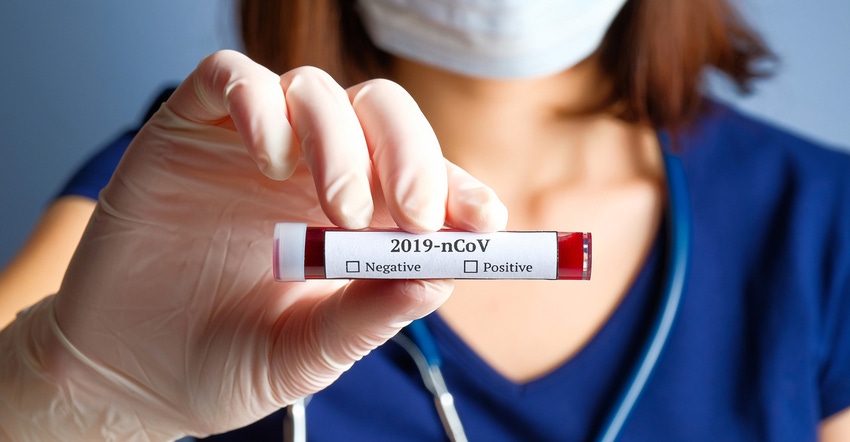April 24, 2020

Many people infected with COVID-19 show few symptoms of the disease or none at all, so researchers at Ohio State University are creating a blood test that could detect the true extent of the pandemic.
The researchers have also assisted OSU’s Wexner Medical Center physicians, who have created a treatment for severe cases of COVID-19 using the blood plasma of people who have had COVID-19 and beaten it.
Both the blood test for COVID-19 and the plasma treatment for those suffering from the disease could be critical in understanding and controlling the current pandemic.
Related: Complete coronavirus coverage
Antibody blood test in development
Unlike the standard nasal swab test being used to diagnose COVID-19, the test OSU scientists — including some at the College of Food, Agricultural and Environmental Sciences (CFAES) — are developing is an antibody blood test. The test will determine whether an individual has COVID-19 by checking if his or her blood contains proteins the body produces to fight the disease.
Currently, people tested for COVID-19 are mostly those with signs of severe respiratory disease after other illnesses have been ruled out. That includes the common flu. But the sneaky nature of the novel coronavirus is that someone can be infected with the virus and show no signs.
“The most important thing in a virus outbreak is detection,” says Scott Kenney, a researcher in the CFAES Food Animal Health Research Program (FAHRP). “The way screening is working now, it’s underrepresenting the number of people who have the virus.”
CFAES researchers are working with the Wexner Medical Center physicians on these antibody blood tests,, which are expected to be available in the coming months.
A serology test, also known as an immunity test, is done by collecting a blood sample from a patient suspected of having COVID-19, and then analyzing it for antibodies to the virus. These types of tests are often used to diagnose various types of viruses.
Determining immunity in individuals
“Knowing who is immune to COVID-19 is important for identifying workers who might safely return to work,” says Linda Saif, a FAHRP faculty member and co-director of the Viruses and Emerging Pathogens section of OSU’s Infectious Diseases Institute.
“It’s also important for identifying health care providers who could work with the sickest patients or perform the hospital procedures more likely to expose them to the virus.”
Serology testing will be important to understand how many people have had the virus, Kenney says.
If researchers begin seeing infection numbers around 60%, “then we achieve something called ‘herd immunity,’ where enough people might be immune to limit the rapid spread of the virus,” Kenney says. “Once we reach these goals, we can — cautiously — start returning to normal lives.”
Blood plasma treatment for COVID-19
By contributing to the development of the serology tests, Kenney, Saif and their colleagues in FAHRP collaborated with the Wexner Medical Center, which in turn created a plasma treatment for the most critically ill patients suffering from COVID-19.
A person infected with the virus that causes COVID-19 typically reacts by producing antibodies. Blood plasma, the liquid part of blood containing those antibodies, can be transferred to a patient actively fighting the coronavirus to treat the disease.
“This therapy has shown promise,” Kenney says. “It’s definitely another tool for emergency physicians to consider helping those in critical need.”
This treatment option, known as convalescent plasma therapy, is commonly used to treat other viruses, including the Spanish flu and Ebola, a deadly virus for people and animals that is primarily contained to sub-Saharan Africa.
Recovered patient plasma has proven effective, to some extent, in other cases of viral infection where drugs have not been developed yet.
Plasma therapy used in critically ill patients
Convalescent plasma therapy typically is used for patients who do not seem to be getting better with other treatments: people in life-threatening situations. It is not used with individuals having more mild symptoms of COVID-19, because it is better for them to fight the virus without the assistance of plasma from another individual.
“The most effective use of this therapy would be in hospitalized patients to decrease disease severity and also alleviate their need to be transferred to the ICU,” Saif says. “But if enough donors and convalescent plasma are available, this therapy could also be administered to the front-line heath care workers to prevent their infection.”
Along with Saif and Kenney, the FAHRP team collaborating with the Wexner Medical Center on COVID-19 research also includes Anastasia Vlasova and Qiuhong Wang, both of whom are assistant professors.
DeMartini is a technical editor for OSU CFAES.
Source: OSU CFAES, which is solely responsible for the information provided and is wholly owned by the source. Informa Business Media and all its subsidiaries are not responsible for any of the content contained in this information asset.
Read more about:
Covid 19You May Also Like




